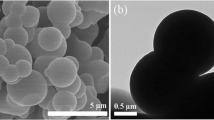Abstract.
Surface-conductive particles consisting of a poly(methyl methacrylate) (PMMA) core and a polyaniline (PA)-coated shell were synthesized and adopted as suspended particles for electrorheological (ER) fluids. The PA–PMMA composite particles synthesized were monodisperse and spherical in shape. The PA–PMMA suspensions in silicone oil showed typical ER characteristics under an applied electric field. The PA–PMMA composite particles possess a higher dielectric constant and conductivity than the pure PA particle, within an acceptable conductivity range for ER fluids, but the PA-based ER fluid showed larger shear-stress enhancement than the PA–PMMA-based systems. This phenomena can be explained by the interfacial polarizability of PA-based ER fluids, which is the difference between the ER fluid's dielectric constant and loss factor – this polarizability was higher than that of PA–PMMA-based ER fluids, as shown by the dielectric spectrum of each fluid. The insulating PMMA core suppressed the interfacial polarization in ER fluids, resulting in reduced interaction among particles under an imposed electric field.
Similar content being viewed by others
Author information
Authors and Affiliations
Additional information
Electronic Publication
Rights and permissions
About this article
Cite this article
Cho, .Y., Cho, .M., Choi, .H. et al. Electrorheological characterization of polyaniline-coated poly(methyl methacrylate) suspensions. Colloid Polym Sci 280, 1062–1066 (2002). https://doi.org/10.1007/s00396-002-0698-8
Received:
Accepted:
Issue Date:
DOI: https://doi.org/10.1007/s00396-002-0698-8




